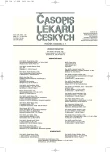Addictive diseases and finances – relevant relationships
Authors:
K. Nešpor; A. Scheansová
Authors‘ workplace:
Psychiatrická léčebna Bohnice a Institut postgraduálního vzdělávání ve zdravotnictví, Praha
Published in:
Čas. Lék. čes. 2009; 148: 335-337
Category:
Special Articles
Overview
Alcohol, other addictive substances and gambling are economically clearly disadvantageous. The financial losses caused by addictive problems should be more compensated by taxation. There are also compelling health reasons for higher taxation. Uncontrolled and accessible financial resources and also poverty represent the risk factors especially for adolescents. Poverty also limits the affordability of psychotherapeutic and medical services for the large segments of population. Material and financial aspects often motivate people to seek treatment for their addictive problems. We also mention the fact that the treatment and especially prevention are economically profitable for individuals, families and societies.
Key words:
addictive diseases, prevention, financial aspects, economics, psychotherapy, family therapy.
Sources
1. Jha P, Chaloupka FC. Curbing the epidemic: Governments and the economics of tobacco control. The World Bank 1999. Available: http: //www1.worldbank.org/tobacco/
2. Johansson E, Böckerman P, Uutela A. Alcohol consumption and sickness absence: evidence from microdata. Eur J Public Health 2009; 19(1): 19–22.
3. Siahpush M, Wakefield MA, Spittal MJ, Durkin SJ, Scollo MM. Taxation reduces social disparities in adult smoking prevalence. Am J Prev Med 2009; 36(4): 285–291.
4. Wagenaar AC, Salois MJ, Komro KA.Effects of beverage alcohol price and tax levels on drinking: a meta-analysis of 1003 estimates from 112 studies. Addiction 2009; 104(2): 179–190.
5. Koski A, Sirén R, Vuori E, Poikolainen K. Alcohol tax cuts and increase in alcohol-positive sudden deaths: a time-series intervention analysis. Addiction 2007; 102(3): 362–368.
6. Markowitz S, Chatterji P, Kaestner R. Estimating the impact of alcohol policies on youth suicides. J Ment Health Policy Econ 2003; 6(1): 37–46.
7. Segal DS, Stockwell T. Low alcohol alternatives: a promising strategy for reducing alcohol related harm. Int J Drug Policy 2009; 20(2): 183–187.
8. Baumann M, Spitz E, Guillemin F, Ravaud JF, Choquet M, Falissard B, Chau N; Lorhandicap group. Associations of social and material deprivation with tobacco, alcohol, and psychotropic drug use, and gender: a population–based study. Int J Health Geogr 2007; 6: 50.
9. Haustein KO. Smoking and poverty. Eur J Cardiovasc Prev Rehabil 2006; 13(3): 312–318.
10. Shapiro M. Money: a therapeutic tool for couples therapy. Fam Process 2007; 46(3): 279–291.
11. Dutra L, Stathopoulou G, Basden SL, Leyro TM, Powers MB, Otto MW. A meta-analytic review of psychosocial interventions for substance use disorders. Am J Psychiatry 2008; 165(2): 179–187. http: //ajp.psychiatryonline.org/cgi/content/full/165/2/ 179, accessed 1. 4. 2009.
12. Volpp KG, Troxel AB, Pauly MV, Glick HA, Puig A, Asch DA, Galvin R, Zhu J, Wan F, DeGuzman J, Corbett E, Weiner J, Audrain-McGovern J. A randomized, controlled trial of financial incentives for smoking cessation. N Engl J Med 2009; 360(7): 699–709.
13. Sigmon SC, Higgins ST. Voucher-based contingent reinforcement of marijuana abstinence among individuals with serious mental illness. J Subst Abuse Treat 2006; 30(4): 291–295.
14. Wu LT, Kouzis AC, Schlenger WE. Substance use, dependence, and service utilization among the US uninsured nonelderly population. Am J Public Health 2003; 93(12): 2079–2085.
15. Rockloff MJ, Schofield G. Factor analysis of barriers to treatment for problem gambling. J Gambl Stud 2004; 20(2): 121–126.
16. Gollust SE, Schroeder SA, Warner KE. Helping smokers quit: understanding the barriers to utilization of smoking cessation services. Milbank Q 2008; 86(4): 601–627.
17. Bush TM, McAfee T, Deprey M, Mahoney L, Fellows JL, McClure J, Cushing C. The impact of a free nicotine patch starter kit on quit rates in a state quit line. Nicotine Tob Res 2008; 10(9): 1511–1516.
18. van den Berg M, van Baal PH, Tariq L, Schuit AJ, de Wit GA, Hoogenveen RT. The cost-effectiveness of increasing alcohol taxes: a modelling study. BMC Med 2008; 6: 36. www.biomedcentral.com/1741–7015/6/36
19. Fleming MF, Mundt MP, French MT, Manwell LB, Stauffacher EA, Barry KL. Benefit-cost analysis of brief physician advice with problem drinkers in primary care settings. Med Care 2000; 38(1): 7–18.
20. Zarkin GA, Bray JW, Aldridge A, Mitra D, Mills MJ, Couper DJ, Cisler RA; COMBINE Cost-Effectiveness Research Group. Cost and cost-effectiveness of the COMBINE study in alcohol-dependent patients. Arch Gen Psychiatry 2008; 65(10): 1214–1221.
21. Nešpor K. Návykové chování a závislost. Třetí aktualizované vydání. Praha: Portál 2007; 176.
Labels
Addictology Allergology and clinical immunology Angiology Audiology Clinical biochemistry Dermatology & STDs Paediatric gastroenterology Paediatric surgery Paediatric cardiology Paediatric neurology Paediatric ENT Paediatric psychiatry Paediatric rheumatology Diabetology Pharmacy Vascular surgery Pain management Dental HygienistArticle was published in
Journal of Czech Physicians

Most read in this issue
- Bilateral spontaneous pneumothorax – wrong therapies
- Human genome sequencing – next generation technology or will the routine sequencing of human genome be possible?
- Eosinophils in the gastrointestinal tract
- On human ageing and longevity – 2. internal determinants
